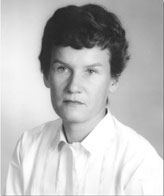Home Page
A Many-Sided Life
 Challenges did not faze Ada V. Wester (MFA '53). A resourceful, matter-of-fact woman, Ada homesteaded 160 acres north of Alamogordo, New Mexico, on a limited income and bred Appaloosa horses. Nor did conventions limit her: Ada pursued careers in nursing, the military, and fine art during an era when many American women made their livings as homemakers.
Challenges did not faze Ada V. Wester (MFA '53). A resourceful, matter-of-fact woman, Ada homesteaded 160 acres north of Alamogordo, New Mexico, on a limited income and bred Appaloosa horses. Nor did conventions limit her: Ada pursued careers in nursing, the military, and fine art during an era when many American women made their livings as homemakers.
First Loves
Born in Jacksonville, Florida, Ada grew up poor. Her father was a factory worker. Young Ada loved art, particularly drawing and music. However, influenced by an uncle who was a physician, Ada decided to go into nursing first and return to art later. She received her nursing degree from Charity Hospital of Nursing in New Orleans in 1941. The following year, she entered the Army and served in World War II as a second lieutenant in the Army Nurse Corps.
"She was very adventurous," says her nephew, Stick Lamar, "and World War II was where the adventure was. Duty called, and one thing led to another."
The head nurse aboard various Army hospital ships, Ada witnessed action in the Mediterranean, the Pacific, and Europe. Her six years of service in the Army earned her the Armed Forces Reserve Medal, the American Campaign Medal, the European-African-Middle Eastern Campaign Medal, the Asiatic-Pacific Campaign Medal, a Bronze Star, and a World War II Victory Medal.
Going West
Ada reentered civilian life with characteristic determination and spirit. She earned a bachelor's degree in fine arts from Columbia University in 1951 then moved to New Mexico, receiving a master's degree in fine arts from UNM in 1953. After graduation, Colonel John Paul Stapp, M.D., chief of the Aeromedical Field Laboratory at Holloman Air Force Base near Alamogordo, contacted her to gauge her interest in working at the facility. Ada went to work there as an illustrator, conceptualizing new missile designs on paper in the days before ultra-sophisticated software programs. She also served as Col. Stapp's nurse; for as a pioneer in determining the effects of acceleration and deceleration on humans, he often injured himself during his experiments.
In the mid-1950s, Ada moved to Alamogordo. An animal lover and horse owner, she became interested in homesteading land. After locating 160 acres, submitting her application along with a proposal of what she intended to do with the land, and waiting several months, Ada became a homesteader. She spent her free time building a cabin, drilling an irrigation well, cultivating 20% of her land, and caring for her animals. She grew a herd of registered Appaloosas from her original mare and foal and was a member of the National Appaloosa Horse Club. At the time of her death in April 2006, she was the last homesteader in Otero County.
"She was self-reliant," says Lamar. "She did everything on her own. Her farm was a home for animals, not a moneymaking farm. She grew up during the Great Depression and lived like a pauper."
A Return to Art
The demands of home, horse-breeding, and patriotism didn't satiate Ada's curiosity and skill. In the 1960s she built both an art studio and a respectable art career. She had solo exhibitions in the Art Gallery of the Museum of New Mexico in Santa Fe, the Paul Schuster Gallery in Cambridge, Massachusetts, and in the permanent collections of galleries in New Mexico, New York, New Jersey, Arizona, and Oregon. "She helped us in the La Luz Gallery," says her longtime friend Ernie Lee Miller. "We met when she was an illustrator at the base. Then she had a studio in the building where the gallery was. She was very knowledgeable [about art] and I valued her opinion, so I'd ask her what I should do about this or that."
Another of Ada's passions was genealogy. She traced her family tree and helped friends find their roots as well. She met a man, married and moved to New Orleans, but split up with him after about six months of marriage because she couldn't bear being away from her farm and beloved horses. Although Ada had many friends in the various spheres of her life, she didn't reveal much of herself to anyone, according to Lamar and Miller.
"She was so private," Miller says. "I knew her at least 20 years, but there were whole segments of her life that I knew nothing about. We talked about art, and my husband talked to her about farming."
Quiet Generosity
Her love for and enjoyment of art moved her to establish a bequest to benefit UNM students. In addition, her graduate days at UNM were very special to her.
"She came west from New York, and it was an exciting time for her," says Lamar. "New Mexico still had a pioneering spirit at that time. She had a lot of great friends, artsy types. I'm not sure, but I have an idea that because she was starving during her college years that she wanted to help make it easier for other students."
The bequest, Ada's entire estate as well as the sale of her artwork, was channeled into scholarships for undergraduate studio arts students. The first scholarships were awarded in the fall of 2007. Recipients were chosen on the basis of achievement and financial need. Through her generosity, Ada Wester is a great example of what someone of even modest means can do to benefit future generations of UNM students.
© Pentera, Inc. Planned giving content. All rights reserved.
Disclaimer
